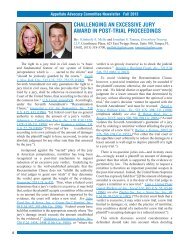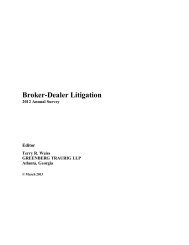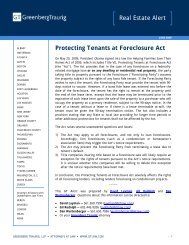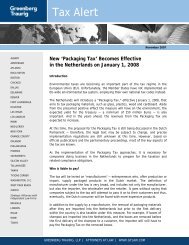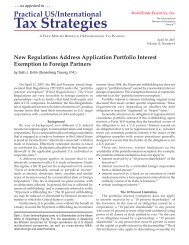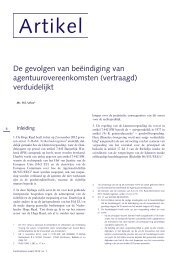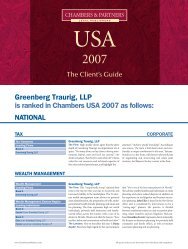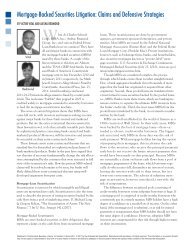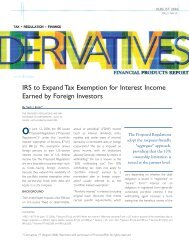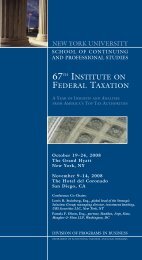- Page 1 and 2:
Broker-Dealer Litigation 2011 Annua
- Page 3 and 4:
Rocky Pozza Miller, Canfield, Paddo
- Page 5 and 6:
3. Safe Harbor/Bespeaks Caution Def
- Page 7 and 8:
(iii) Falsification of Documents...
- Page 9 and 10:
SECURITIES LITIGATION A. Definition
- Page 11 and 12:
Purvis v. Arizona Corp. Comm’n, N
- Page 13 and 14:
allegation of fraud. The complaint
- Page 15 and 16:
Silverstrand Investments v. AMAG Ph
- Page 17 and 18:
complaint lacked named plaintiffs w
- Page 19 and 20:
egarding loan-to-value ratios repor
- Page 21 and 22:
appraisers’ alleged acceptance of
- Page 23 and 24:
that statutes of repose are not sus
- Page 25 and 26:
Pension Trust Fund for Operating En
- Page 27 and 28:
Securities Exchange Act of 1934. Th
- Page 29 and 30:
authorities versus those reported i
- Page 31 and 32:
In re Oppenheimer Rochester Funds G
- Page 33 and 34:
claims as to the appraisal standard
- Page 35 and 36:
under Section 12 and declined to ex
- Page 37 and 38:
however, the court found that the s
- Page 39 and 40:
that a mutual fund’s share price
- Page 41 and 42:
allege a material misrepresentation
- Page 43 and 44:
over common questions, given the nu
- Page 45 and 46:
lending practices; and its solvenci
- Page 47 and 48:
partnership and worked to obtain in
- Page 49 and 50:
Section 12(a)(2) required the court
- Page 51 and 52:
initially inflated the company’s
- Page 53 and 54:
B.2 Self v. Chase Bank, N.A., 2011
- Page 55 and 56:
“associated with,” or “acted
- Page 57 and 58:
Gibbons v. Nat’l Real Estate Inve
- Page 59 and 60:
avoid ambiguous, potentially mislea
- Page 61 and 62:
B.3 SEC v. Kelly, 2011 WL 44331161
- Page 63 and 64:
B.3 SEC v. Woodruff, 778 F. Supp. 2
- Page 65 and 66:
C. Liabilities under the Securities
- Page 67 and 68:
easonable juror could conclude that
- Page 69 and 70:
Claimants requested compensatory da
- Page 71 and 72:
C.1.d Ashland Inc. v. Morgan Stanle
- Page 73 and 74:
C.1.d AnchorBank, FSB v. Hofer, 649
- Page 75 and 76:
experiencing large operating losses
- Page 77 and 78:
C.1.d Resnik v. Woertz, 744 F. Supp
- Page 79 and 80:
substantial likelihood that disclos
- Page 81 and 82:
C.1.d In re Evergreen Ultra Short O
- Page 83 and 84:
In re Merrill Lynch Auction Rate Se
- Page 85 and 86:
fiduciary duty and negligent misrep
- Page 87 and 88:
corporation’s earnings forecasts
- Page 89 and 90:
C.1.e In re Bank of America Corp. S
- Page 91 and 92:
f. Affirmative Defenses Wilson v. M
- Page 93 and 94:
that the complaint failed to allege
- Page 95 and 96:
immaterial; or (3) made without act
- Page 97 and 98:
of the Private Securities Litigatio
- Page 99 and 100:
held that the statute of limitation
- Page 101 and 102:
C.1.f In re Novatel Wireless Securi
- Page 103 and 104:
parent company liable for statement
- Page 105 and 106:
C.1.g SEC v. Tecumseh Holdings Corp
- Page 107 and 108:
C.1.g Fishman v. Morgan Keegan & Co
- Page 109 and 110:
C.2 Litwin v. Oceanfreight, Inc., 2
- Page 111 and 112:
Hysong v. Encore Energy Partners LP
- Page 113 and 114:
and created an uncertainty that KBR
- Page 115 and 116:
consented to the entry of a final j
- Page 117 and 118:
3. Section 15(c) C.3 SEC v. Ficeto,
- Page 119 and 120:
SEC v. Stifel, Nicolaus & Co., Inc.
- Page 121 and 122:
settled with the SEC prior to the c
- Page 123 and 124:
equity interests in real estate ass
- Page 125 and 126:
noted that the SEC had “merely re
- Page 127 and 128:
ing such court actions (the “1990
- Page 129 and 130:
D. Liabilities under the Securities
- Page 131 and 132:
its’ liquidity problems and plans
- Page 133 and 134:
few of defendant’s employees were
- Page 135 and 136:
D.1 Dronsejko v. Thornton, 632 F.3d
- Page 137 and 138:
In re Smith & Wesson Holding Corp.
- Page 139 and 140:
particularized as materially mislea
- Page 141 and 142:
D.1 Stephenson v. Pricewaterhouseco
- Page 143 and 144:
D.1 Russo v. Bruce, 777 F. Supp. 2d
- Page 145 and 146:
D.1 Jacquemyns v. Spartan Mullen Et
- Page 147 and 148:
granted the defendants’ motion to
- Page 149 and 150:
D.1 Egan v. Tradingscreen, Inc., 20
- Page 151 and 152:
City of Roseville Employees’ Reti
- Page 153 and 154:
D.1 Solow v. Citigroup, Inc., 2011
- Page 155 and 156:
Local 731 I.B. of T. Excavators and
- Page 157 and 158:
D.1 Love v. Alfacell Corp., 2011 WL
- Page 159 and 160:
disregarded and resulted in omissio
- Page 161 and 162:
dismiss finding that plaintiff’s
- Page 163 and 164:
from a decline of defendant’s sto
- Page 165 and 166:
plaintiffs failed to (i) create str
- Page 167 and 168:
D.1 In re St. Jude Med., Inc. Sec.
- Page 169 and 170:
D.1 Scala v. Citicorp Inc., 2011 WL
- Page 171 and 172:
granted defendants’ motion to dis
- Page 173 and 174:
improperly recognized revenue on sa
- Page 175 and 176:
D.1 Henning v. Orient Paper, Inc.,
- Page 177 and 178:
plaintiffs alleged that defendants
- Page 179 and 180:
in various contracts of the company
- Page 181 and 182:
D.1 In re Crocs, Inc. Securities Li
- Page 183 and 184:
Phila. Fin. Mgmt. of S.F., LLC v. D
- Page 185 and 186:
Waterford Twp. Police & Fire Ret. S
- Page 187 and 188:
Group met the requirements of Fed.
- Page 189 and 190:
appointed a lead plaintiff. The cou
- Page 191 and 192:
IBEW Local 90 Pension Fund v. Deuts
- Page 193 and 194:
D.2 Vandevelde v. China Natural Gas
- Page 195 and 196:
typicality.” Accordingly, the cou
- Page 197 and 198:
D.2 Sparano v. Lief, 2011 WL 830109
- Page 199 and 200:
argument was irrelevant because the
- Page 201 and 202:
issue, and therefore qualified for
- Page 203 and 204:
was not available. Moreover, the co
- Page 205 and 206:
misstatements were shielded from li
- Page 207 and 208:
D.3 Hopson v. MetroPCS Commc’ns,
- Page 209 and 210:
D.3 In re St. Jude Med., Inc. Sec.
- Page 211 and 212:
D.3 Curry v. Hansen Med., Inc., 201
- Page 213 and 214:
D.3 In re Coinstar Sec. Litig., 201
- Page 215 and 216:
Plumbers and Pipefitters Local Unio
- Page 217 and 218:
E. Backus v. Conn. Cmty. Bank, N.A.
- Page 219 and 220: Securities Litigation Uniform Stand
- Page 221 and 222: willfully ignored numerous red flag
- Page 223 and 224: material facts “relating to” th
- Page 225 and 226: E. Northstar Fin. Advisors, Inc. v.
- Page 227 and 228: precluded or removable under SLUSA.
- Page 229 and 230: circumvent SLUSA, the Court of Appe
- Page 231 and 232: of defendant purchased ARS bonds fr
- Page 233 and 234: 2. Consumer Protection and Other St
- Page 235 and 236: F.3 Borsellino v. Putnam, 2011 WL 6
- Page 237 and 238: F.4 Haase v. GunnAllen Fin., Inc.,
- Page 239 and 240: that the complaint failed to allege
- Page 241 and 242: eing directed to return improperly
- Page 243 and 244: H.1 U.S. v. Reyes, 660 F.3d 454 (9t
- Page 245 and 246: to dismiss the complaint pursuant t
- Page 247 and 248: Act of 1934 alleging it made false
- Page 249 and 250: and Rule 10b-5 of the Securities Ex
- Page 251 and 252: exert control over the content of c
- Page 253 and 254: H.2 In re Sanofi-Aventis Sec. Litig
- Page 255 and 256: Camofi Master LDC v. Riptide Worldw
- Page 257 and 258: solvency. The district court held t
- Page 259 and 260: (1) the investment corporations’
- Page 261 and 262: held that, in taking plaintiffs’
- Page 263 and 264: Rule 10b-5 claims were pleaded with
- Page 265 and 266: to judgment as a matter of law beca
- Page 267 and 268: H.2 Rafton v. Rydex Series Funds, 2
- Page 269: those reasons, the court granted th
- Page 273 and 274: Fernea v. Merrill Lynch, Pierce, Fe
- Page 275 and 276: 3. Aiding & Abetting H.3 Janus Capi
- Page 277 and 278: of trades by defendants did not amo
- Page 279 and 280: violation of securities laws. To st
- Page 281 and 282: H.3 Merkin v. Gabriel Capital, L.P.
- Page 283 and 284: allegedly illegal fundraising at de
- Page 285 and 286: to any of the claims except the “
- Page 287 and 288: mere suspicion that the broker-deal
- Page 289 and 290: H.4 U.S. v. Speer, 419 F. App’x 5
- Page 291 and 292: equirements of Federal Rule of Civi
- Page 293 and 294: compliance officer testified as a r
- Page 295 and 296: In re Torrey Pines Sec. Inc., Relea
- Page 297 and 298: In re Torrey Pines Sec. Inc., Relea
- Page 299 and 300: or nationally-recognized statistica
- Page 301 and 302: activity, including activity in the
- Page 303 and 304: timely and complete information upd
- Page 305 and 306: J. RICO J. MLSMK Inv. Co. v. JP Mor
- Page 307 and 308: J. In re Refco Inc. Sec. Litig., 20
- Page 309 and 310: Beaman v. Barth, 2011 Bankr. LEXIS
- Page 311 and 312: General Retirement System of City o
- Page 313 and 314: K. Damages and Other Relief in Priv
- Page 315 and 316: K.2 U.S. v. Gushlak, 2011 WL 315917
- Page 317 and 318: K.2 Elipas v. Jedynak, 2011 WL 1706
- Page 319 and 320: are wanton and reckless when done i
- Page 321 and 322:
settlement agreement constituted an
- Page 323 and 324:
The court held that the trustee was
- Page 325 and 326:
L. Contribution, Indemnification L.
- Page 327 and 328:
L. MBIA Ins. Corp. v. Credit Suisse
- Page 329 and 330:
warranted under these circumstances
- Page 331 and 332:
1933. In opposition to the motions,
- Page 333 and 334:
M.1 SEC v. Wyly, 788 F. Supp. 2d 92
- Page 335 and 336:
as barred by the statute of repose
- Page 337 and 338:
equitable estoppel did not apply as
- Page 339 and 340:
support the FINRA arbitration as pr
- Page 341 and 342:
N.1 Citibank, N.A. v. Franco, 2011
- Page 343 and 344:
ecause it overlapped with and was p
- Page 345 and 346:
2. Eligibility/Limitations N.2 Yuan
- Page 347 and 348:
the legislature did not intend the
- Page 349 and 350:
Plaintiff in fact derived a direct
- Page 351 and 352:
arbitrator the right to determine w
- Page 353 and 354:
and ordering of all parties into ar
- Page 355 and 356:
impeachment upon proof of changed c
- Page 357 and 358:
N.4.c Aviles v. Charles Schwab & Co
- Page 359 and 360:
S.Ct. 1784 (2010). Prior to Merck,
- Page 361 and 362:
market sector downturn rendered the
- Page 363 and 364:
defendants had misrepresented the n
- Page 365 and 366:
allegations did not reference parti
- Page 367 and 368:
were disclosed by the timely filing
- Page 369 and 370:
improper attempt to file the Third
- Page 371 and 372:
O.3 In re Evergreen Ultra Short Opp
- Page 373 and 374:
would primarily focus on establishi
- Page 375 and 376:
the power of a sovereign.” It was
- Page 377 and 378:
the admission by the investment man
- Page 379 and 380:
permit exercise of personal jurisdi
- Page 381 and 382:
anyway because the connection to ba
- Page 383 and 384:
5. Discovery O.5 Mori v. Saito, 802
- Page 385 and 386:
O.5 Davis v. Duncan Energy Partners
- Page 387 and 388:
censure, a civil money penalty of $
- Page 389 and 390:
anch office, which did not have any
- Page 391 and 392:
In re Application of Kaminski, Admi
- Page 393 and 394:
prejudgment interest. The payment w
- Page 395 and 396:
Specifically, the firm’s procedur
- Page 397 and 398:
In re Pagliarini, Admin. Proc.File
- Page 399 and 400:
firm settled charges that it violat
- Page 401 and 402:
capacities. The NAC cited the fact
- Page 403 and 404:
maintain and enforce a system of su
- Page 405 and 406:
The hearing panel found respondents
- Page 407 and 408:
firm also consented to findings tha
- Page 409 and 410:
In re Keybanc Capital Markets, Inc.
- Page 411 and 412:
$30,000 civil fine, disgorgement of
- Page 413 and 414:
The Commission’s complaint allege
- Page 415 and 416:
Commission, a federal district cour
- Page 417 and 418:
(ii) Misrepresentation Q.1.c.(ii) I
- Page 419 and 420:
Q.1.c(ii) In re Chiaese, Release No
- Page 421 and 422:
The Commission censured the Firm. A
- Page 423 and 424:
particular, CSIM and CS&Co. markete
- Page 425 and 426:
Q.1.e.(i) SEC v. Devlin, Litig. Rel
- Page 427 and 428:
clearance trades without being a re
- Page 429 and 430:
Q.1.e(ii) In re Huntleigh Sec. Corp
- Page 431 and 432:
assisted in the Firm’s creation o
- Page 433 and 434:
Q.1.e(iii) In re Schaefer, Release
- Page 435 and 436:
and hedge fund accounts, to the det
- Page 437 and 438:
f. Failure to Supervise Q.1.f In re
- Page 439 and 440:
Firm policy disallowing wires from
- Page 441 and 442:
The Commission alleged that Lopez-T
- Page 443 and 444:
suspension concerning his complianc
- Page 445 and 446:
Commission barred LeBouef from asso
- Page 447 and 448:
Direct Edge ECN LLC, doing business
- Page 449 and 450:
(ii) Falsification of Documents . N
- Page 451 and 452:
unavailable, Gizankis and FINRA agr
- Page 453 and 454:
j. Procedural Issues (i) Evidence N
- Page 455 and 456:
FINRA Rule 2010 by submitting an an
- Page 457 and 458:
R. Broker-Dealer Employment Litigat
- Page 459 and 460:
discovery responses was also meritl
- Page 461 and 462:
R. Frankel v. McDonough, 2011 WL 50
- Page 463 and 464:
must not have ruled on that defense
- Page 465 and 466:
FINRA award was entitled to full fa
- Page 467 and 468:
Lorbietzki v. Merrill Lynch, Pierce
- Page 469 and 470:
failed to show that it was prejudic
- Page 471 and 472:
Antelis v. Freeman, 2011 WL 6009609
- Page 473 and 474:
Berman v. Morgan Keegan & Co., 2011
- Page 475 and 476:
Citigroup Smith Barney v. Henderson
- Page 477 and 478:
Department of Enforcement v. Hedge
- Page 479 and 480:
FINRA Department of Enforcement v.
- Page 481 and 482:
Grecco v. Local.Com Corp., 806 F. S
- Page 483 and 484:
IAC/InterActiveCorp v. O’Brien, 2
- Page 485 and 486:
In re Cell Therapeutics, Inc. Class
- Page 487 and 488:
In re Franklin Bank Corp. Sec. Liti
- Page 489 and 490:
In re Kim, Release No. 64862, 2011
- Page 491 and 492:
In re Mutascio, Release No. 65351,
- Page 493 and 494:
In re Shankar, Release No. 64714, 2
- Page 495 and 496:
In re Wash. Mut. Mortgage-Backed Se
- Page 497 and 498:
KeyBank, N.A. v. Bingo, Coast Guard
- Page 499 and 500:
Marini v. Adamo, 2011 WL 4442710 (E
- Page 501 and 502:
McCafferty v. A.G. Edwards & Sons,
- Page 503 and 504:
Murray v. Citigroup Global Mkts., I
- Page 505 and 506:
Picard v. Madoff (In re Bernard L.
- Page 507 and 508:
Rafton v. Rydex Series Funds, 2011
- Page 509 and 510:
SEC v. Aragon Capital Advisors, LLC
- Page 511 and 512:
SEC v. N. Am. Clearing, Inc., Litig
- Page 513 and 514:
Solow v. Citigroup, Inc. , 2011 WL
- Page 515 and 516:
U.S. Bank N.A. v. Cold Spring Grani
- Page 517:
West Va. Laborers Trust Fund v. STE



